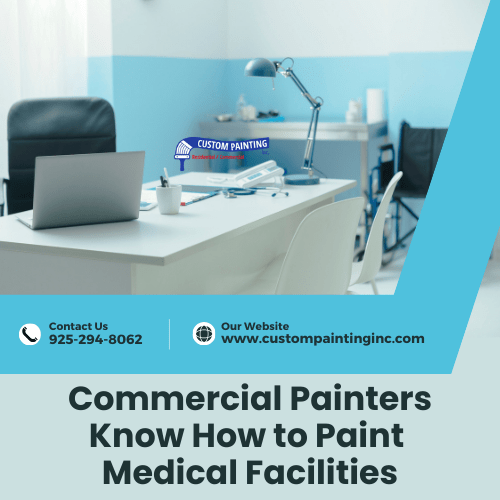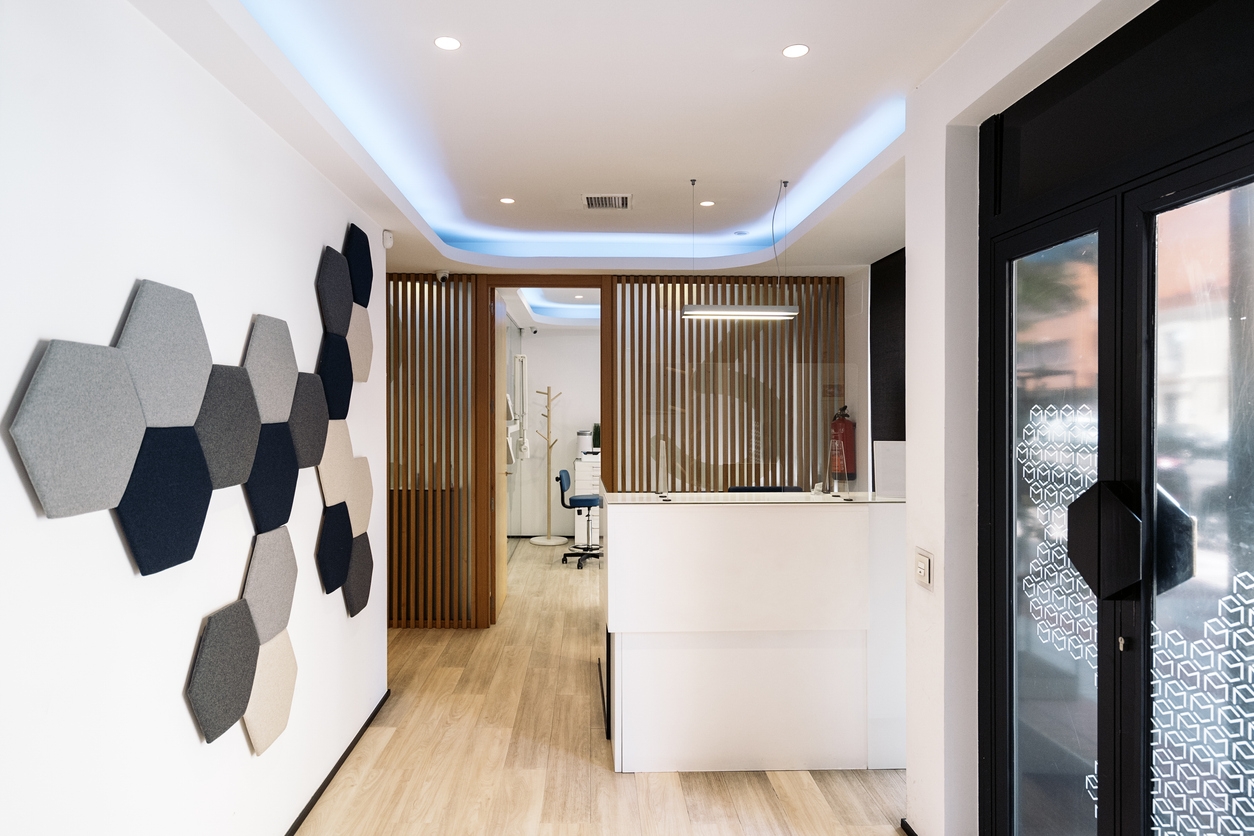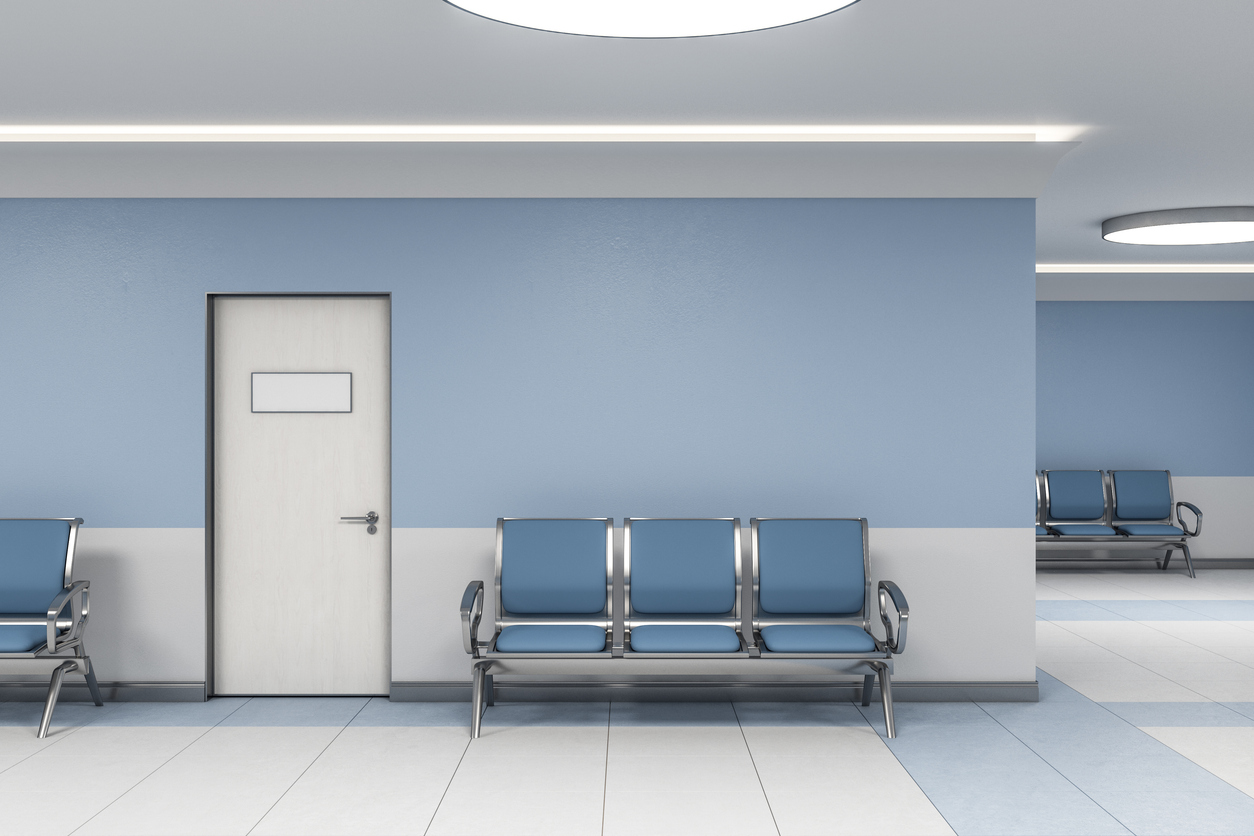Applying a fresh coat of paint is one of the cost-effective ways to give a Concord, CA area office or business space a new look and feel. Most offices and commercial spaces require the usual prep and paint work – cleaning, repairs (if any), priming, and painting. It can also include specific challenges such as wood rot repair, rusty metal door painting and more. But when it comes to painting medical facilities, commercial painters know it won’t be the same as painting an office, retail store, or restaurant.
Painting a medical facility can be tricky
Painting a medical facility requires a unique approach compared to painting an office or other commercial spaces because of the specialized environment, its purpose, and the health and safety of patients, staff, and visitors. Here’s a detailed breakdown of the key differences:
1. Health and safety concerns
- Low-VOC and odorless paints: Medical facilities must use low-VOC (volatile organic compound) or zero-VOC paints to minimize the release of harmful fumes, which can cause respiratory issues or allergic reactions in sensitive individuals.
- Antimicrobial coatings: These paints prevent the growth of bacteria, mold, and mildew, contributing to a hygienic environment.
2. Specialized ventilation
- Effective ventilation systems: Proper ventilation is crucial to dissipate paint fumes quickly, ensuring air quality remains safe. Exhaust systems and air scrubbers may be required during painting.
- Negative air pressure: In areas like surgical suites or patient isolation rooms, maintaining specific air pressure standards may be necessary to prevent contamination.
3. Infection control
- Dust control: Ensuring that sanding and painting do not create dust, which could harbor bacteria or contaminants.
- Cleanability: Paint must create surfaces that are easy to clean and sanitize without degrading over time.
4. Compliance with regulations
- Healthcare standards: Painting projects in medical facilities must align with standards from bodies like the CDC, OSHA, or local health departments.
- Fire resistance: Paints used in medical facilities must often be fire-resistant or meet specific flammability standards.
5. Patient-centric design
- Color psychology: Colors chosen must promote calmness and healing. For example, soft greens, blues, and neutral tones are common to reduce stress and create a soothing environment.
- Minimizing disturbance: Paint schedules are planned to minimize noise and disruption, particularly in inpatient areas.
6. Durability and longevity
- High-traffic durability: Walls in medical facilities face more wear and tear due to equipment movement and high foot traffic. The paint must be highly durable and resistant to stains.
- Touch-up feasibility: Frequent touch-ups should be easy without creating visual inconsistencies.
7. Coordination with facility operations
- Phased painting: Painting is often done in phases to keep parts of the facility operational. Temporary barriers or containment areas might be used.
- Working hours: Painting often occurs during off-hours or less busy times to reduce disruption to patients and staff.
Addressing these specific needs ensures a safe, functional, and aesthetically pleasing environment while prioritizing the health of everyone in the facility.
Types of medical facilities
Medical facilities range from large hospitals in cities to small-town clinics. Either way, experience in painting these buildings is essential for all individuals who use and work in them.
1. General medical facilities
- Hospitals (e.g., inpatient wards, emergency rooms, surgical suites)
- Clinics (e.g., outpatient services, general practitioners’ offices)
- Urgent care centers
- Ambulatory surgical centers
2. Specialized medical facilities
- Diagnostic and Imaging Centers (e.g., MRI, CT scan rooms)
- Rehabilitation centers (e.g., physical therapy, occupational therapy)
- Dialysis centers
- Oncology clinics (e.g., chemotherapy rooms)
- Radiology centers
3. Dental and vision care offices
- Dental offices (e.g., treatment rooms, waiting areas)
- Orthodontic clinics
- Vision clinics (e.g., optometry and ophthalmology offices)
4. Pediatric and family health facilities
- Pediatric clinics
- Maternity and neonatal care units
- Family medicine clinics
5. Mental and behavioral health facilities
- Counseling offices
- Psychiatric hospitals
- Substance abuse treatment centers
6. Geriatric and long-term care facilities
- Nursing homes
- Assisted living facilities
- Memory care units
7. Laboratories and research facilities
- Medical laboratories
- Pathology labs
- Pharmaceutical research facilities
8. Specialized surgical and procedural facilities
- Plastic surgery clinics
- Orthopedic clinics
- ENT (Ear, Nose, and Throat) clinics
9. Specialized therapy facilities
- Speech therapy clinics
- Chiropractic offices
- Sports Medicine clinics
10. Wellness and preventative care centers
- Physical wellness clinics
- Health screening centers
- Immunization clinics
11. Veterinary medical facilities
- Animal hospitals
- Veterinary clinics
Each facility has distinct functional and aesthetic needs, impacting choices for paint type, finish, color palette, and application techniques. For example, pediatric clinics might require playful, bright colors and durable finishes, while mental health facilities may benefit from calming tones and matte finishes to reduce glare.
The challenges and considerations of painting medical facilities
Handling medical equipment
Commercial painters encounter multi-million-dollar medical equipment, which requires meticulous handling. They must carefully handle or work around expensive medical equipment to prevent damage or contamination. This often involves coordinating with staff to temporarily move or cover equipment with protective materials, ensuring it remains clean and functional while maintaining access to critical areas during the painting process.
Air quality
Air quality is a significant challenge when painting medical facilities because fumes, dust, and VOCs from paint can spread through shared ventilation systems, affecting patients, staff, and other offices. This risk is especially critical in areas with immunocompromised patients. Painters must use low-VOC or odorless paints, seal off work areas, and employ proper ventilation strategies, such as air scrubbers or negative pressure systems, to maintain safe air quality throughout the facility.
Flexible scheduling
Flexible scheduling is essential when painting medical facilities to minimize disruptions to operations and patient care. Painters often work during off-hours, weekends, or in carefully planned phases, ensuring critical areas remain accessible and the facility functions smoothly while the work is completed.
Special wall paints and floor coatings
Special wall and floor coatings are used in medical facilities to meet hygiene and durability standards. These include antimicrobial paints to inhibit bacteria and mold growth, washable coatings for easy cleaning, and non-slip floor coatings to enhance safety in high-traffic or wet areas.
Maintaining a clean work area
Painters must maintain a clean work area in Benicia, CA area medical facilities to prevent dust, debris, or paint spills from affecting patients, staff, and equipment. This involves using drop cloths, sealing off work zones, regularly cleaning up during and after painting, and disposing of materials safely to uphold strict hygiene and safety standards.
Color selection
Color selection in Lafayettem CA area medical facilities focuses on creating a calming, clean, and healing environment. Here are some color selection suggestions for various areas in medical facilities:
- Waiting rooms: Soft blues, greens, or neutral tones like beige or light gray create a calm, relaxing environment. Accent colors, like muted oranges or yellows, can add warmth without overwhelming the space.
- Pediatric office: Bright, cheerful colors like pastel blues, greens, and yellows or playful themes with soft primary colors help create a friendly, comforting atmosphere for children and families.
- Surgical suites: Cool tones like soft blues or greens are preferred to promote a calm, focused environment. These colors also help reduce visual stress for medical staff during long procedures.
- Treatment rooms: Neutral tones like light gray or warm beiges with calming accents in soft blues or greens can provide a serene, professional atmosphere while helping patients feel at ease.
- Consultation rooms: Muted, professional colors like soft grays, light blues, or beige create a respectful and calm setting, encouraging open communication between patients and healthcare providers.
- Facility for the elderly: Warm, soft tones such as light yellows, pale greens, and soft blues can create a welcoming and soothing environment. Contrasting colors on walls or trim can help improve visibility and ease navigation for those with visual impairment.
Consider the ceiling
When painting ceilings in medical facilities in Walnut Creek, particularly in patient rooms, it’s important to choose calming, light colors like soft whites, off-whites, or pale blues. Since patients often lie on their backs and look up at the ceiling, these colors help create a soothing and less sterile atmosphere. Additionally, using a matte or low-sheen finish minimizes glare, reducing visual discomfort for patients during their stay.
What can you expect from Custom Painting, Inc.?
Custom Painting, Inc. is knowledgeable and experienced in painting medical facilities of all types.
- Experienced in interior and exterior painting services
- Knowledgeable about durable coatings
- Knowledgeable about color selections (including color matching to keep within uniformity)
- Use of low-VOC, zero-VOC, and “green” paints and coatings
- Flexibility to paint during off-hours
- Skilled in communicating and working with facility administration and property managers
- Avoiding disruption to services and care to patients and facility staff
- A meticulous and thorough clean-up at the end of every workday
- Compliance with the paint industry and healthcare standards
Custom Painting, Inc. has general liability and workers’ compensation insurance so that you, your staff, and your patients are completely protected. If your hospital, clinic, or another medical facility in Concord is in need of a fresh paint job, contact us today at 925-686-0903 for a free consultation or complete our Contact form, and we’ll contact you.




